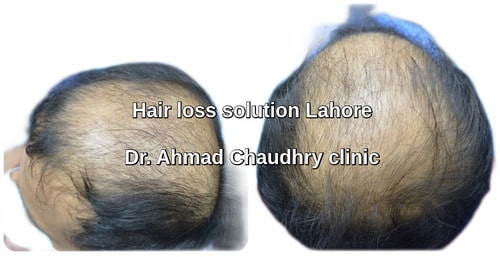Hair loss solution hair transplant clinic Lahore is providing the best remedy to restore glory of head. It is a major cause of distress for many patients, now can be treated with a lot of different hair loss treatment modalities available. Depending on the cause of alopecia, whether its diffuse or patchy, hereditary or non-hereditary, inflammatory or non-inflammatory i.e., mediated by stress and anxiety, related to skin conditions or infections like tinea capitis. Detailed history and physical examination with a variety of tests available now, help to distinguish one form of alopecia from the other and decide the modality of treatment that should be used for a particular type of baldness. Physical examination should be focused on the scalp with signs of other comorbid conditions by reviewing systems. The pull test might be helpful in determining the type of alopecia.
Hair loss treatments based on different types of baldness are described with each type. Androgenic alopecia, the most common form of baldness in men with hereditary predisposition and becomes more prominent with aging, is usually physiological. Treatment modalities for this type of alopecia include Minoxidil solution 2% that is topically applied to the scalp. Regrowth takes about 6 to 12 months and the treatment is continued indefinitely. Some side effects may occur including contact dermatitis. Finasteride, given per oral, is effective in individuals in whom minoxidil have been ineffective in treating androgenic alopecia. Side effects include gynecomastia, erectile dysfunction etc.
Autoimmune or infectious causes of alopecia have different hair loss treatment options available. Alopecia areata, that mostly affects children without any gender specificity, is caused by an autoimmune process that results in circumscribed patchy alopecia on any body part or scalp. It is usually treated by injecting intralesional triamcinolone acetonide intradermally, with 3ml per session maximum volume. It requires a minimum 4-6 weeks of treatment. Side effects are telangiectasia and transient atrophy. Topical mild to high potency steroids are also helpful. In addition, minoxidil, immunotherapy and systemic corticosteroids also prove beneficial.
Tinea capitis, caused by dermatophyte infection of the shaft and the follicle, mainly affects children. There is patchy baldness with or without scaling. It requires systemic treatment with antifungal agents, as topical agents do not penetrate the follicles. Treatment modalities are oral terbinafine, itraconazole, fluconazole and griseofulvin. As it is necessarily a fungal infection that can be transmitted by close contact, all the contacts of the patient should be examined and treated simultaneously, if there is any sign of disease present.
Telogen effluvium, is a kind of non-scarring and non-inflammatory alopecia. Hair loss treatment options are also available for this disease. The trigger factors include severe chronic illness, stress, pregnancy, endocrine disorders, high fever, surgery, malnutrition and severe infections. Treatment with certain medicines including oral contraceptive pills, antithyroid drugs, anticonvulsants, retinoids, anticoagulants and beta blockers may also be the causative factor. There is uniform hair thinning. Lab investigations show evidence of underlying disease processes. It is usually self-limiting and is resolved in about 6 months. Treatment includes removing the causative factor and treating underlying disease.
Trichotillomania, is an impulse control dysfunction in which patients usually unconsciously or consciously pull or twist their hair. Psychiatric treatment is usually required and includes cognitive behavioral therapy and selective serotonin reuptake inhibitors.
Trichorrhexis Nodosa occurs when hair breaks secondary to trauma. Excessive physical trauma or chemical injury to hair due to certain scalp products are the initiating factor. Treatment options include avoiding any kind of physical and chemical trauma. For all kinds of baldness, hair transplant surgery might be helpful if all other treatment options have failed and the baldness still persists. Surgery requires good preoperative preparation of patients, fine surgical skills and a very appropriate and good care postoperatively. It takes about 6 month to show some visible difference in growth of follicles.
People also search
| PRP treatment | 2254 grafts before after |
Get FREE consultation | Call or WhatsApp | +923334309999



